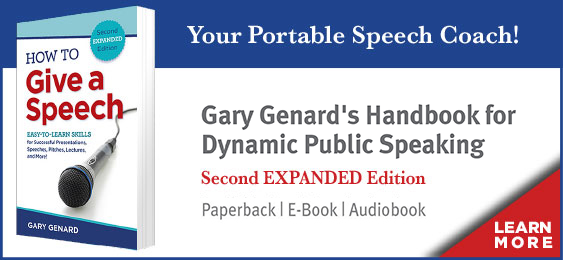
Are you missing out on a foolproof way to engage your audience? Learn how to excite listeners immediately so they're eager to hear what you have to say!
"Why should this audience listen to me?"
That's the question each of us should ask ourselves—in the planning stage, preparing to speak, and when we're actually delivering our talk. After all, it's just too easy to become speaker-centric as presenters. Sure, this is our speech and our prestige is on the line. But audience members are always in a "What's-in-it-for-me mode." And if people don't sense that it's all worthwhile, why would they listen?
All of this means that the start of your speech, presentation, pitch, or lecture is critically important. That's when audiences should get the strong impression that you're about to say something they need to listen to.
Want to know more on how to increase your influence and credibility with listeners? Discover how to align your content with your audience's expectation and shape your message for clarity and consistency. Learn how to lverage your power as a speaker! Download my essential cheat sheet, Leadership Skills: The 5 Essential Speaking Techniques.
Today, I'd like to discuss a presentation element that's too often left out of this equation. It should always be part of your speech's opening, because it can mean the difference between an audience that's engaged and excited versus one that's passive and uninterested.
So here's some advice on getting your audience onboard with your topic quickly and reliably.

How to Start a Speech: Grab Your Audience
In a previous article, I discussed powerful ways that you can answer the question, "How should I start my speech?" The reason you need to know how to do this, is because of two concepts that help determine your success or failure as a speaker: primacy and recency.
"Primacy" states that audiences retain best what they experience first. Obviously, then, part of your job is to hook listeners by letting them know (as best you're able to) that your topic is irresistable.Here's my earlier article on 12 foolproof ways to start a speech or presentation. "Recency" tells us that audiences strongly retain what they experience last. That means you should send listeners away enthused and ready for action.

Your Preview Starts Your Audience on Their Journey
Let's say you followed the advice in my earlier piece and started your speech off with a bang. What comes after this "grabber" is equally important. Unfortunately, too many speakers leave out this important segment of their presentation. This is the moment when you tell your audience where you're going together—and equally important, why they should listen. Here are some other skills you need to connect with your audience in the first 60 seconds.
I call this speech element Where We're Going Together and Why It Matters to You—and I saw the importance of it recently in my practice. My client was a scientist preparing to present his research to colleagues. He took a standard approach to his PowerPoint talk: introduce himself briefly, then dive at the steepest possible angle into the specifics of his research.
In our debrief, I asked him what his purpose was in speaking to this audience. He told me it was to educate them about a rare finding that emerged in the research that had mystified him. He was talking to this group to alert them, in case they ran across this easily misunderstood test result in their own research. I saw immediately then what was missing in his opening.
Before we began again, I suggested that he mention what he had just told me to his audience. That is, after he revealed his topic, he should share with them why he thought they needed to know this information. The equation is a simple one that will work with your talks as well: When you let an audience know how your talk will benefit them and make their life easier, you guarantee their engagement. They'll have answered in their own minds the "What's in it for me?" question, and they'll be engaged and possibly excited by what follows.

Use Emotion to Get Listeners Turned On
The third way you can excite and activate your audience is through the conscious use of emotional language. It's something I also see frequently in my work as a speech coach: a speaker wants to create a strong emotional response in an audience, but doesn't use any language that will help the cause.
Your data and sheer information provide the overall picture. But nothing moves an audience like emotional language, delivered by you with passion. Here's how to get the ratio of content to practice right to give your best performance. Before you speak, review your text: Are you using language that's serviceable but not engaging, exciting, inspiring, or activating? And in your practice sessions and videotaping: do you truly sound as though you mean it?
No need to chew the scenery, as we say in the theater. But the truth is, too many business and professional speakers play it safe, staying well away from the edge of what they feel is inappropriate passion. Believe me, the edge is probably a lot farther away than you think.
Besides receiving the best information in the world, your listeners need to know you care.
You should follow me on Twitter here.
And take a look at my latest book!



